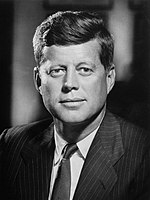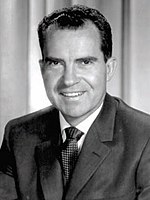1960 United States presidential election in Hawaii
| ||||||||||||||||||||||||||
| Turnout | 93.1%[1] | |||||||||||||||||||||||||
|---|---|---|---|---|---|---|---|---|---|---|---|---|---|---|---|---|---|---|---|---|---|---|---|---|---|---|
| ||||||||||||||||||||||||||
 County Results
| ||||||||||||||||||||||||||
| ||||||||||||||||||||||||||
| Elections in Hawaii |
|---|
 |
The 1960 presidential election in Hawaii was held on November 8, 1960, as part of the 1960 United States presidential election. This was the first presidential election in which Hawaii participated; the state had been admitted to the Union just over a year earlier. The islands favored Senator John F. Kennedy, a Democrat, by a narrow margin of 115 votes, or 0.06%, after a court-ordered recount overturned an initial result favoring Vice President Richard Nixon, a Republican. The result was considered an upset, as Nixon had been thought likely to win the state's electoral votes.[1]
This was the last time Hawaii voted more Republican than the national average until 1972, when it voted 0.8% more Republican than the national average. This is also one of only two elections in which Hawaii's counties did not all back the same candidate, the other being 1980, where the winner of each county was of the opposite party as in 1960. Unlike in the 1960 election, Honolulu voting Republican in 1980 was not sufficient to single-handedly carry the state, while all three other counties voted for Jimmy Carter.[2]
The election, and the subsequent recount, are notable for giving rise to the first occurrence of "dueling" electoral slates in American history since the 1887 enactment of the Electoral Count Act.[3] During the 2000 United States presidential election recount in Florida, Congresswoman Patsy Mink suggested that the election could serve as a potential precedent to extend Vice President Al Gore's challenge to the official results beyond the Electoral Count Act's "safe harbor" deadline, though this was ultimately not acted upon.[4] During the attempts to overturn the 2020 United States presidential election, the election was cited as a potential precedent by supporters of President Donald Trump.[5][6]
Recount[]
Early unofficial totals suggested that Kennedy had won the state by 92 votes. However, errors in the official tabulation sheets reversed this result, instead suggesting a 141-vote victory for Nixon. Democrats highlighted various apparent errors in the tabulation, including 34 precincts where the number of total votes cast in the precinct was smaller than the sum of Nixon's and Kennedy's vote totals, and other precincts where the number of total votes cast was much larger than the combined votes for Nixon and Kennedy.[1]
On November 22, attorney Robert G. Dodge filed a recount petition on behalf of thirty members of the Hawaii Democratic Party in a Honolulu circuit court. Dodge did not allege any voter fraud, instead merely observing that the tabulation sheets were not consistent in various precincts. State Republican Party officials also considered supporting the recount petition, but were internally divided and eventually declined to join it. One elector on the Republican slate, O. P. Soares, opposed the recount petition. All three electors on the Republican slate were named as defendants, along with Republican Lieutenant Governor James Kealoha, who at the time was serving as acting governor of the state and would be required to sign any certificate of ascertainment. Attorney General Shiro Kashiwa also joined the suit to represent the state's interests.[7][1][8]
Despite the apparent tabulation errors, Acting Governor Kealoha certified Nixon's 141-vote victory on November 28.[9] Kealoha certified the result after two audits of the tabulation sheets by his office,[10] and may have had no option other than to certify, as he lacked authority to inspect or retabulate the actual ballots cast.[1]
Litigation was still ongoing on December 13, the safe harbor deadline for certification under the Electoral Count Act. As only the Republican slate had so far been certified by the state's governor, its votes would be the only ones eligible for safe harbor status. Republicans argued that the litigation should end, since even if the recount should result in a Kennedy victory, under the rules of the Electoral Count Act Congress was required to presume that the Republican electors were the validly appointed electors for Hawaii.[8]
However, the following day, the presiding circuit court judge ordered a partial recount to begin. A limited retabulation showed Nixon's margin over Kennedy decreasing, and as more ballots were opened and retabulated on subsequent days, Nixon's lead shrank and eventually disappeared. By December 18, the partial recount showed Kennedy leading Nixon in the state by 55 votes.[8]
The recount was thus still ongoing on December 19, the day specified in U.S. law for the casting of votes by the members of the Electoral College. As a consequence, both the officially certified Republican slate of electors (Gavien A. Bush, J. Howard Worrall, and O. P. Soares) and an "unofficial" Democratic slate of electors (Jennie K. Wilson, William H. Heen, and Delbert E. Metzger) convened in the ʻIolani Palace and cast competing electoral votes for Nixon and Kennedy just one minute apart.[1][11] Certificates for both slates' electoral votes were sent to Franklin G. Floete, the Administrator of General Services.[7]
Also on December 19, Jamieson ordered a complete statewide recount, which concluded on December 28 and showed a Kennedy victory by 115 votes.[8] Based on this recount, Jamieson ordered that the Democratic slate of Wilson, Heen, and Metzger be named the validly appointed presidential electors for the state of Hawaii on December 30. Attorney General Kashiwa declined to appeal the verdict, and Governor William F. Quinn, a Republican, certified the Democratic slate of electors on January 4, 1961, in a letter to Administrator Floete.[7][1] The state government also rushed a letter to Congress by air mail to indicate that a new certification was on its way.[11]
During the Congressional joint session to tabulate electoral votes on January 6, 1961, Nixon (who presided over the session in his capacity as President of the Senate), presented both the Republican and Democratic electoral certificates. To head off the possibility of a floor objection by Democrats such as Representative Daniel K. Inouye,[6] Nixon then requested and received unanimous consent from the joint session for the Democratic certificate to be counted and the Republican certificate to be set aside, though he specified that this was being done "without the intent of establishing a precedent".[12][7]
References[]
- ^ a b c d e f g Tuttle, Daniel W. Jr. (March 1961). Anderson, Totton J. (ed.). "The 1960 Election in Hawaii" (PDF). The Western Political Quarterly. The 1960 Elections in the West. University of Utah. 14 (1, Part 2): 331–338. doi:10.2307/443854. JSTOR 443854 – via SAGE Journals.
- ^ "Presidential election of 1980 - Map by counties". Geoelections.free.fr. Retrieved 2021-09-25.
- ^ Corasaniti, Nick; Rutenberg, Jim (15 December 2020). "No, there aren't 'alternate electors' who can vote for President Trump". Nytimes.com. Retrieved 16 January 2022.
- ^ "What the 1960 Hawaii Presidential Election Meant for Bush v. Gorer". Pointoforder.com. Retrieved 16 January 2022.
- ^ Kilgore, Ed (29 December 2020). "The Flimsy Nixon Precedent Trump Is Seizing On to Contest Biden's Win". Nymag.com. Retrieved 16 January 2022.
- ^ a b "What happens when a state can't decide on its electors". Rollcall.com. 26 October 2020. Retrieved 16 January 2022.
- ^ a b c d 107 Cong. Rec. 289-290 (1961) (statement of Vice President Richard Nixon), link
- ^ a b c d "How To Decide A Very Close Election For Presidential Electors: Part 2 | Take Care". Takecareblog.com. Retrieved 16 January 2022.
- ^ "Nixon Victor in Hawaii". The New York Times. New York, NY. 1960-11-17. Retrieved 2022-01-15.
- ^ "Recount Sought in Hawaii". The New York Times. New York, NY. 1960-11-22. Retrieved 2022-01-15.
- ^ a b "Honolulu Star-Bulletin Editorial". Archives.starbulletin.com. Retrieved 16 January 2022.
- ^ The Presidential Election and Transition, 1960–1961: Brookings Lectures and Additional Papers. Brookings Institution. 1961. p. 152.
- 1960 United States presidential election by state
- United States presidential elections in Hawaii
- 1960 Hawaii elections
- Western United States election stubs
- Hawaii stubs


